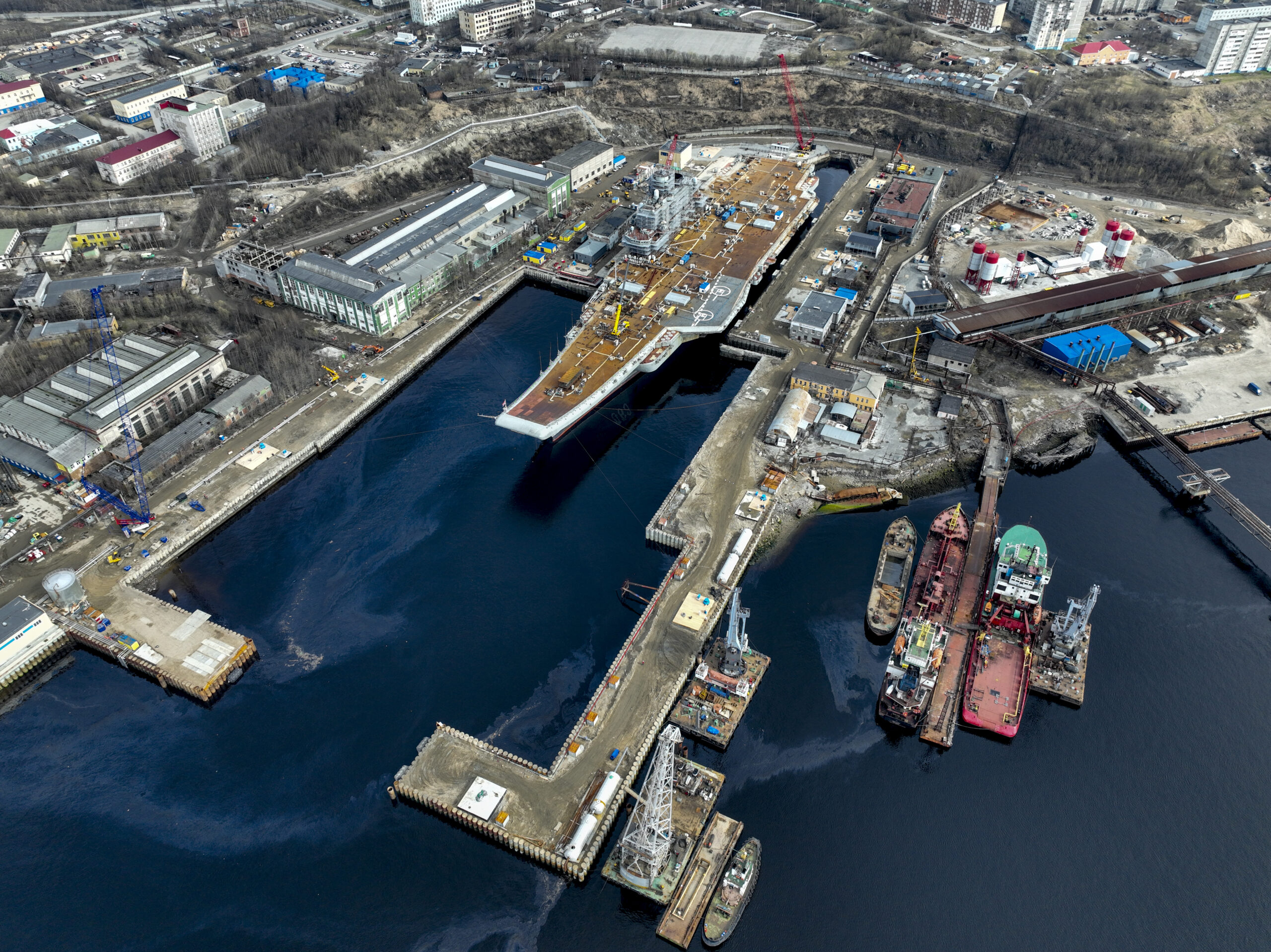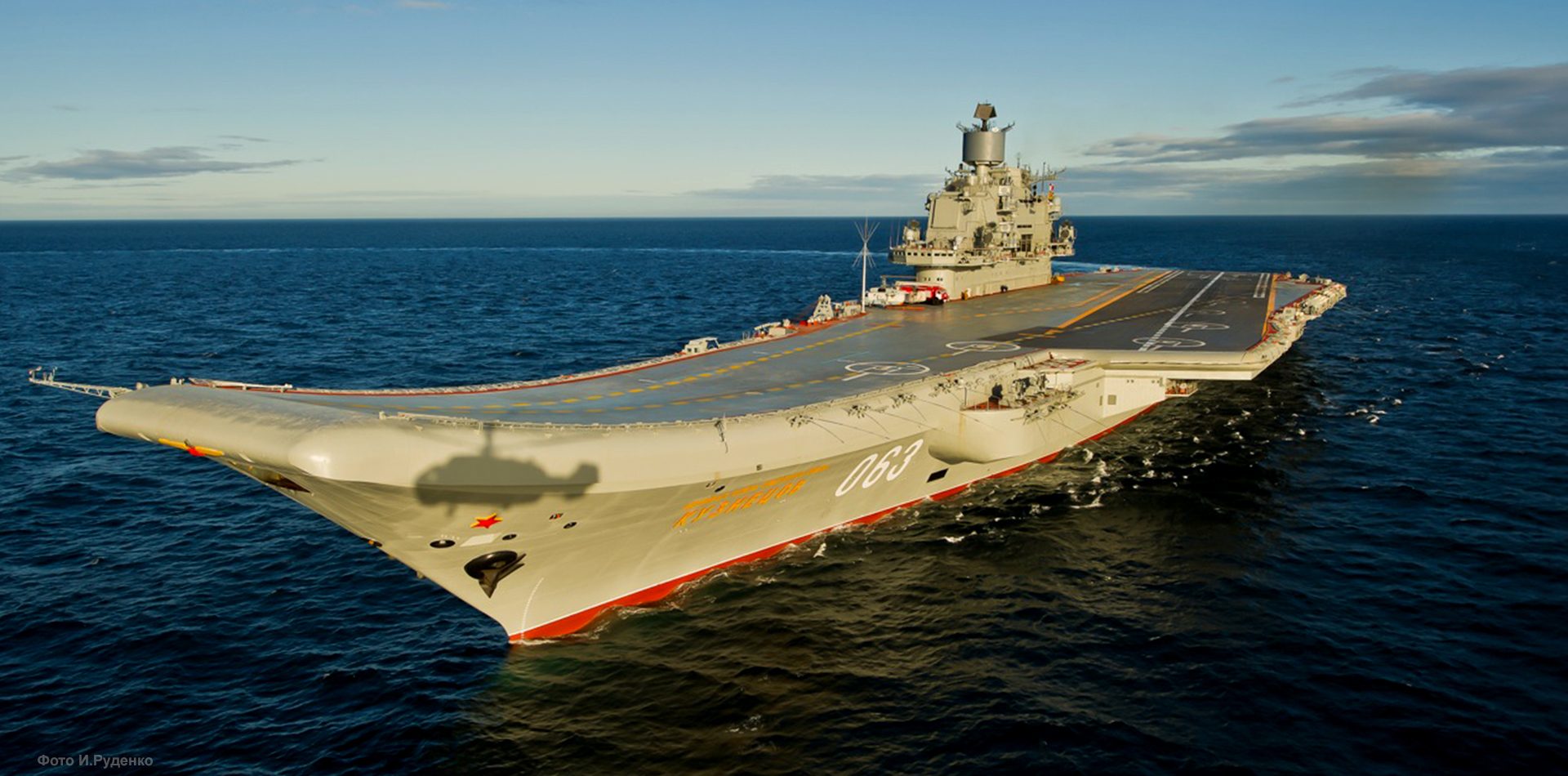The Russian military’s only aircraft carrier, Admiral Kuznetsov, has left its drydock at the Sevmorput Naval Shipyard in the country’s northwestern Murmansk region.
Admiral Kuznetsov was moved to its specially built drydock in Sevmorput, also known as Shipyard Number 35 or the 35th Shipyard, in May 2022. For over three years before that, the carrier was undergoing work in port at the shipyard after having to relocate from Russia’s largest floating drydock PD-50 following its unexpected sinking right from underneath the flattop in October 2018. This was just one in a string of unfortunate events that have plagued an overhaul effort Admiral Kuznetsov has been undergoing since 2017.
Footage of Admiral Kuznetsov leaving the 35th Shipyard’s drydock emerged on Telegram after being shared by Zvezda, the official media outlet of the Russian Ministry of Defense. The clips show Admiral Kuznetsov being pulled into Kola Bay just outside the shipyard by at least one tugboat, with other vessels seen nearby supporting the operation.
A corresponding machine-translated article published by Zvezda said that Admiral Kuznetsov left the drydock to the song “Farewell of Slavianka,” a Russian patriotic march. The story also quotes Alexei Rakhmanov, the head of United Shipbuilding Corporation, which is a Russian government-owned company dedicated to administering military construction and maintenance contracts, in saying that the aircraft carrier has left its drydock because “all work on the underwater part of the ship had already been completed.” Exactly what that work entailed wasn’t specified.
The Russian military first began removing Admiral Kuznetsov from drydock in December of last year. At the time, the Russian TASS News Agency reported that the operation would take a month to complete. With the ship only now having officially left drydock in late February of 2023, the overall process ultimately lasted nearly two months.

Russia’s efforts to find a drydock solution big enough for Admiral Kuznetsov after the sinking of the country’s massive floating drydock PD-50, the country’s largest, in October 2018, highlight shortcomings in Russia’s naval support infrastructure. Readers of The War Zone can learn more about these implications in this past article.
The sudden loss of PD-50 prompted a long scramble to build a new drainable basin at the 35th Shipyard that could adequately fit the aircraft carrier. The drydock Admiral Kuznetsov has now left was made by combining two existing drydocks together, extending them, and then pulling the aircraft carrier inside, before damning the area up and draining it.
In an apparent decision to expedite the construction process, a purpose-built gate for the drydock wasn’t built, so the ship was physically walled in and the water was then pumped out in a process that can take two to three months. The reverse of which was required to pull out Admiral Kuznetsov, and the frigid weather of Russia’s winter months could have very well contributed to the timeframe of the operation.
A year after PD-50 sank and while construction of the ship’s new drydock at the 35th Shipyard was underway, Admiral Kuznetsov caught fire, only adding to the aircraft carrier’s ill-fated saga. At the time, TASS explained that the blaze occurred because safety rules were violated during repairs of one of the ship’s power units.
This wasn’t the first or last time the ship had become engulfed in flames either. A separate incident occurred in 2009, which can be seen in the video below, that led to the loss of a sailor’s life from smoke inhalation. Another fire broke out aboard the ship just last December but was quickly extinguished. Admiral Kuznetsov was prone to accidents of various kinds while in service, including some rather embarrassing fighter operations on its last cruise that featured the then-new MiG-29KR as well as aging Su-33s.

Needless to say, Admiral Kuznetsov has been beset by issues for its entire career. The aircraft carrier is even shadowed by an ocean-going tug in case of emergencies. Regardless, work on the ship is said to have persisted in some capacity throughout these misfortunes.
The overhaul of Admiral Kuznetsov began in 2017 after it returned from its first and only combat deployment to Syria. The overarching effort, the scope of which was scaled back significantly the same year it kicked off, looks to extend the service life of the ship. It also aims to make it more reliable to operate, as well as provide enhancements to its dated combat systems.

Russia is aiming to complete this overhaul by 2024 with the goal of keeping Admiral Kuznetsov in service for another decade or more, but this timeline is not guaranteed. Even still, being its only aircraft carrier, a working and operational Admiral Kuznetsov is clearly seen as a worthwhile asset for the Russian Navy, although that is a very debatable position in naval warfare circles. Still, the service doesn’t want to give up on it.
Continuing to funnel money into Admiral Kuznetsov has been seen by some as a questionable investment for Russia when it could instead be used to realize other potentially more sustainable and usable efforts. Having to expand the drydock at the 35th Shipyard alone ate up its own fair share of resources, and getting Admiral Kuznetsov to working order would just mean that additional operation and maintenance costs will continue in the years to come. This would of course be on top of the needs of its carrier wing which has spent most of its life without a ship to operate from.

These issues have been greatly magnified by Russia’s all-out invasion of Ukraine, which is now about to enter its second year. With mountains of resources being shoveled into the war effort, spending large sums of money fixing and operating an already questionably relevant carrier that will have no role in the war is a somewhat remarkable decision.
Contact the author: Emma@thewarzone.com
